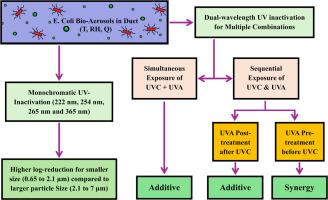单色和复合GUV波长对HVAC管道中空气传播的大肠杆菌灭活的性能评价
IF 7.6
1区 工程技术
Q1 CONSTRUCTION & BUILDING TECHNOLOGY
引用次数: 0
摘要
本研究量化了在中试规模暖通空调管道系统中杀菌紫外线(GUV)对空气中大肠杆菌的波长依赖性消毒性能。在受控的室内条件下(25°C, 40% RH),以三种气流速率(29.05,52.16和79.00 m³/h)测试222,254,265和365 nm的单色紫外源。使用局部辐照度映射和基于计算流体动力学(CFD)的曝光时间建模来确定紫外线通量。265 nm的紫外速率常数最高(k = 1.151 m²/J),其次是222 nm (k = 0.480 m²/J)和254 nm (k = 0.420 m²/J)。在365 nm下,即使在223 J/m²的影响下,也没有观察到可测量的失活。消毒效率随生物气溶胶粒径的增大而降低,粒径较小的生物气溶胶(0.65 ~ 2.1 μm)由于内部紫外线屏蔽作用,比粒径较大的生物气溶胶(2.1 ~ 7.0 μm)具有更高的失活能力。在同时和顺序暴露模式下,对UVA (365 nm)和UVC的双波长组合进行了评估。同时,UVC之后的UVA暴露除了UVC之外没有其他影响。然而,连续的UVA预处理显著提高了所有测试组合的UVC功效,表明协同效应可能是由蛋白质合成、氧化应激和抑制微生物修复机制驱动的,这些机制使细胞对随后的UVC损伤敏感。这些结果表明,波长序列严重影响空气传播消毒结果。这项工作提供了新的证据,支持UVA在UVC配置之前增强微生物灭活,并为暖通空调管道应用中安全节能的多波长GUV系统的设计提供了信息。本文章由计算机程序翻译,如有差异,请以英文原文为准。

Performance evaluation of monochromatic and combined GUV wavelengths for airborne E. coli inactivation in an HVAC duct
This study quantifies the wavelength-dependent disinfection performance of germicidal ultraviolet (GUV) for airborne Escherichia coli in a pilot-scale HVAC duct system. Monochromatic UV sources at 222, 254, 265, and 365 nm were tested at three airflow rates (29.05, 52.16, and 79.00 m³/h) under controlled indoor conditions (25 °C, 40 % RH). UV fluence was determined using localized irradiance mapping and computational fluid dynamics (CFD) based exposure time modeling. Among the tested wavelengths, 265 nm exhibited the highest UV rate constant (k = 1.151 m²/J), followed by 222 nm (k = 0.480 m²/J) and 254 nm (k = 0.420 m²/J). No measurable inactivation was observed under 365 nm, even at fluences as high as 223 J/m².
Disinfection efficiency decreased with increasing bioaerosol size, with smaller particles (0.65–2.1 μm) exhibiting higher inactivation than larger ones (2.1–7.0 μm) due to internal UV shielding. Dual-wavelength combinations of UVA (365 nm) with UVC were evaluated under both simultaneous and sequential exposure modes. Simultaneous, and UVC followed by UVA exposures resulted in no additional effects beyond UVC alone. However, sequential UVA pre-treatment significantly enhanced UVC efficacy across all tested combinations, indicating a synergistic effect likely driven by protein synthesis, oxidative stress and inhibition of microbial repair mechanisms, which sensitize cells to subsequent UVC damage.
These results demonstrate that the wavelength sequence critically influences airborne disinfection outcomes. This work provides new evidence supporting UVA before UVC configurations for enhanced microbial inactivation and informs the design of multi-wavelength GUV systems for safe and energy-efficient air disinfection in HVAC duct applications.
求助全文
通过发布文献求助,成功后即可免费获取论文全文。
去求助
来源期刊

Building and Environment
工程技术-工程:环境
CiteScore
12.50
自引率
23.00%
发文量
1130
审稿时长
27 days
期刊介绍:
Building and Environment, an international journal, is dedicated to publishing original research papers, comprehensive review articles, editorials, and short communications in the fields of building science, urban physics, and human interaction with the indoor and outdoor built environment. The journal emphasizes innovative technologies and knowledge verified through measurement and analysis. It covers environmental performance across various spatial scales, from cities and communities to buildings and systems, fostering collaborative, multi-disciplinary research with broader significance.
 求助内容:
求助内容: 应助结果提醒方式:
应助结果提醒方式:


